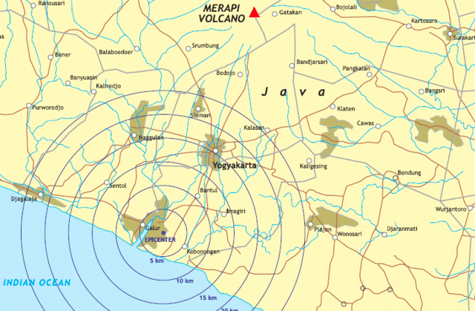Image courtesy of Wikimedia Commons.
Earthquakes are common and sometimes deadly occurrences that can have catastrophic consequences on humans and the environment alike. However, despite their prevalence, the mechanics of earthquakes remain largely unknown. Chun-Yu Ke, who received a Ph.D. in Civil and Environmental Engineering from Cornell University, and his colleagues are interested in developing more accurate earthquake models to better understand how earthquakes stop. Using a dynamic numeric model of a two-dimensional planar fault embedded in a three-dimensional, uniform elastic medium, these researchers could study key seismological quantities and examine how they behave in earthquake arrest.
Earthquakes occur when energy within the Earth’s crust is released and radiates seismic waves, fractures, and heat into the surrounding land. These quakes continue radiating energy and causing fault slips until there is no more available energy for the rock on either side of a fault to continue to move. Ke and his colleagues investigated one particular seismological quantity in earthquake mechanics: breakdown energy. The breakdown energy is the estimated amount of energy dissipated by fault weakening averaged over the rupture area, and it scales approximately linearly with the average fault displacement of the earthquake. Historically, breakdown energy has been regarded as a proxy for fracture energy, the amount of energy it takes to break a particular unit of the surface into entirely separate parts. Researchers previously believed that larger earthquakes, which involve more breakdown energy, also involved more energy in breaking apart units of surface area—that is, bigger earthquakes were thought to have bigger fracture energies.
But Ke’s research turns this idea on its head. When it comes to fracture energy, it is more important to focus on the type of rock being fractured than the amount of energy being applied to the rock. Certain types of rock will require larger fracture energy to break while others will require less—this should not be ubiquitously affected by the magnitude of the earthquake. “When the earthquake hits the rock, the rock doesn’t know how big that earthquake is,” Ke said. “So it shouldn’t be harder or easier to [break] because it’s the same rock.” Indeed, Ke’s findings back this claim. Using a dynamic model, Ke and his colleagues demonstrated that while breakdown energy scales with the size of the earthquake, the fracture energy remains constant throughout. Thus, the amount of energy it takes to break down the rock on the outer rim of an earthquake could be the same regardless of the earthquake’s magnitude. This research suggests that it is time to rethink current seismological models of earthquakes to match this new evidence.
Though Ke’s research lies within somewhat complicated geological processes, it has significant implications for everyone. Ke explains that these mathematical models can ultimately help produce an algorithm that can predict earthquakes. “The definition of an earthquake [prediction] is that you have to determine the time, the location, and the magnitude of an earthquake,” Ke said, “and nobody has ever done that.” Now that the mechanical behaviors and physical properties of earthquakes are becoming better understood with the help of computational models and technologies, the ability to predict earthquakes is within sight. “Maybe one day we can forecast earthquakes like people forecast weather,” Ke said. As earthquake models become more refined with the research of Ke and his colleagues, that hope may become a reality.

